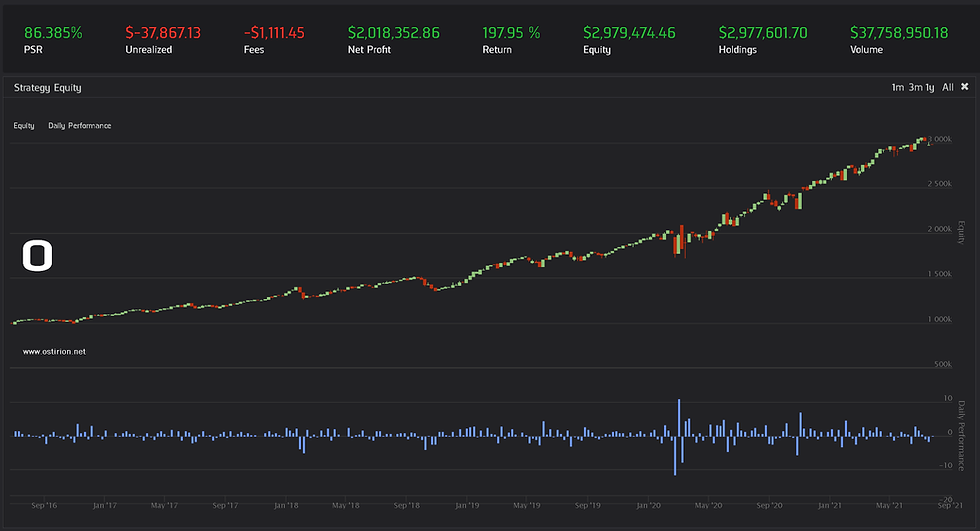On Risk Management and Pseudo-Diversification
- H-Barrio

- Jul 16, 2020
- 5 min read
Updated: Jul 17, 2020
Proper asset risk management is one of the most, if not the most, important component of every asset management strategy. Identifying and mitigating excessive exposure to risk is at the core of any asset management strategy that delivers higher risk-adjusted returns, it is our opinion that identifying high return investment strategies is relatively easy compared to the task of properly managing the risk for these strategies and actually generating risk-adjusted returns. We are not going to discuss the multitude of approaches to managing risk in detail, there are plenty of publications and research on the topic, we are going to focus this post on one such strategy: diversification of assets, and the many problems we may find at the tactical level.
The first issue with diversification is that of employing "pseudo-diversification", that is, seeking diversification across assets that are ultimately correlated. As an example, this are the price evolutions for SPY index and 4 companies from technology, energy, healthcare and finance sectors:

We can see that even if these assets do not follow each other´s price changes closely, when it matters the most (during the onset of the COVID19 crisis) all of them behave very similarly. If you held this set of assets, you were holding a pseudo diversified portfolio with a high stock asset class risk. This is how correlated these assets where during the complete period (end of 2013 to July 2020):

All of our assets except for Exxon Mobil Corporation (XOM) are positively correlated and apparently do not offer much in terms of diversification. Graphically:

Similar colors in the correlation heatmap indicate that the assets move together, and not necessarily with a causal relation between them. If we zoom into the 2019-2020 behaviour the correlation increases, a big market shock is affecting all these assets similarly, in the prices plot:

And in the correlation heatmap:

So, what could we have done to reduce this market risk? We should have looked into other asset classes, if possible assets that are not historically correlated to stocks, and depending on our objective, we may even be looking for negatively correlated assets. The problem with this "true" diversification is that at any given period, one asset class is going to underperform the others and apparently (or better: effectively) is going to be dragging your total returns down. It becomes now a quantitative problem to select the best possible asset basket that minimizes risk and maximizes profit. This is the fundamental problem in asset management and very difficult to solve and prove.
As a very simple example, lets try adding to our analysis some exposure to a different asset class, US treasury bonds. One of the simplest way to achieve this is using an Exchange Traded Fund (ETF) that aims at tracking long term treasury bonds. This of course comes at a price premium as the ETF is going to charge us for maintaining this lock-step with treasury bonds. We can use as an example TLT, that we are going to assume negatively correlated to stocks with a very quick research into this paper. The stocks-bond correlation was generally negative for the largest part of the XXth century, although there is more evidence for positive correlation in the past decade. If we add TLT to our price plots we obtain this:

It can be seen that, in general, TLT is also correlated to the set of stocks, and the correlation heatmap confirms this:

So, why are we wasting your time? The addition of TLT has only increased our risk, this is not what we wanted, this brings us another problem: assets that should be not correlated are under some circumstances (maybe anomalies) correlated. Let's take a close look to the moment we want to reduce risk, we want to hedge against, the last months of 2019 and the beginning of 2020:


During the worst of the downturn, the price of the ETF tracking long term treasury bonds was negatively correlated to stocks. And here is the key for asset risk management, being able to select with certain confidence assets that will cover each other in times of need and that at the same time do not interfere with each other. This becomes a problem of historical (even fundamental) correlation under extreme volatilities. Seeking open-ended, long-calendar time correlations without taking into account other market conditions may not yield good risk management results. Finding an optimal portfolio that acts like this is a highly complex problem and can bring the maximum possible risk-adjusted returns. Verifying and validating such an asset management model is even more difficult if we want to maintain a certain level of statistical significance.
What would have happened if we had held this portfolio of stocks in the past 5 years? A buy-and-hold strategy yields the following:

We do not perform very well. These reputable companies suffer greatly during the end of 2015 mini crisis, then enjoy a bull market and finally the 2020 crisis hits. It is apparent that we are not managing risk properly even if we have four separate sectors represented in our portfolio. Now we will add a 50% of diversification to the portfolio by adding TLT as "anticorrelated" (which is mostly not true) asset:

The results are significantly better, and even this almost-randomly selected portfolio of stocks is made to look better. We can also add an asset that should not be correlated to neither bonds nor stocks, we can add a commodities investment vehicle in the form of gold ETFs such as GLD or AAUU:

Without much research nor analysis we have been able to obtain much better results. These backtests are completed using Quantconnect´s Lean Engine and by default it reports the Probabilistic Sharpe Ratio that gives us an indication on how close we are to an efficient risk-reward ratio. We see this number increase as we add "uncorrelated" (we did not put much science into selecting them) assets. In this last case with stocks, bonds and gold we have a 31.7% probability that the Sharpe Ratio of the strategy is above 1. Not stellar but much better than holding a single asset class.
In this future of high speed trading algorithms and complex machine learning methods the old, common sense approaches seem to still be valid. These new technologies do enable a better risk management through just-in-time diversification and allow us to hold at any given moment the most convenient assets automatically. The unpleasant chore of rebalancing monthly or weekly with mountains of numbers to churn and placing the operation themselves is no excuse now for not holding a really diversified portfolio.
Remember that the posts in our blog are not financial advice. We do not hold any positions on any of the mentioned instruments at the time of publication of this post. If you need further information, asset management support, automated trading strategy development or tactical strategy deployment you can contact us here.



Comments